Terry L. Ettinger Horticulture Consulting Services
Meeting The Needs Of Today With A Vision For The Future
Question of the Week
Tent Caterpillars
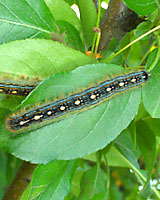 Q. The past couple of years several big shade trees in our have been covered
with small caterpillars with white dots on their backs. They eat a
lot of the leaves, but what's much worse is their "poop!" It's
everywhere and on everything until almost the 4th of July! You can actually sit in the house
and hear it raining down on our roof and deck. What can we do to
keep this disgusting situation from happening again this year?
Q. The past couple of years several big shade trees in our have been covered
with small caterpillars with white dots on their backs. They eat a
lot of the leaves, but what's much worse is their "poop!" It's
everywhere and on everything until almost the 4th of July! You can actually sit in the house
and hear it raining down on our roof and deck. What can we do to
keep this disgusting situation from happening again this year?
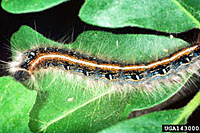 A.
The caterpillar that's been causing all the fuss
throughout Central New York and the North Country the past couple of
years is the "forest" tent caterpillar (above), which is closely
related to the "eastern" tent caterpillar
(at left). Note that the forest tent caterpillars have a row of
"keyhole" or diamond-shaped spots on their back, while eastern tent
caterpillars have a solid, light-colored stripe on their back.
A.
The caterpillar that's been causing all the fuss
throughout Central New York and the North Country the past couple of
years is the "forest" tent caterpillar (above), which is closely
related to the "eastern" tent caterpillar
(at left). Note that the forest tent caterpillars have a row of
"keyhole" or diamond-shaped spots on their back, while eastern tent
caterpillars have a solid, light-colored stripe on their back.
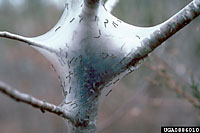 In April and early May, large colonies of eastern tent
caterpillars are noticeable because of the large, silken webs they
often spin in the crotches of wild apple, cherry and hawthorn trees
(at right).
In April and early May, large colonies of eastern tent
caterpillars are noticeable because of the large, silken webs they
often spin in the crotches of wild apple, cherry and hawthorn trees
(at right).
Meanwhile, forest tent caterpillar infestations covering tens of thousands to millions of acres flair up in roughly ten year cycles, with the earliest widespread outbreaks in New York documented in the mid-1800’s. The current cycle appears to have started in roughly 2002 in St. Lawrence county and has spread to well over 30,000 acres in Onondaga and Oswego counties.
These cycles tend to peak after two to four years as a variety of environmental and biological factors start taking their toll on large tent caterpillar populations. These factors include low spring temperatures just prior to and during egg hatch, viral and fungal diseases, predation by other insects, and starvation.
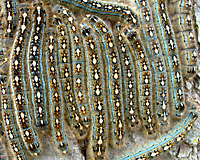 The good news is that for as bad as heavily infested trees may look in mid-June after much of their foliage has been
consumed by forest tent caterpillars, at left, all but the most severely stressed trees will send out a new crop of leaves by the
middle of July. By then the caterpillars will have emerged from their cocoons as one of the many species of brown moths
that are strongly attracted to bright lights during warm summer nights. They'll mate and lay eggs, but do not feed before
dying by late July or early August.
The good news is that for as bad as heavily infested trees may look in mid-June after much of their foliage has been
consumed by forest tent caterpillars, at left, all but the most severely stressed trees will send out a new crop of leaves by the
middle of July. By then the caterpillars will have emerged from their cocoons as one of the many species of brown moths
that are strongly attracted to bright lights during warm summer nights. They'll mate and lay eggs, but do not feed before
dying by late July or early August.
Wow, that's a lot of words, but I still haven't answered your question, have I? Well, to manage this critter, I suggest a combination of physical and biological tactics.
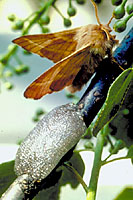 As I mentioned above, female forest tent caterpillar moths lay
masses of eggs around stems the diameter of pencils in mid- to late
July, at right. Once you know what you're looking for, they’re relatively easy
to see during the winter and early spring months when infested trees
are leafless (at left, below). Therefore, one very effective option is to snip off
the stems containing egg masses during the winter months.
Consequently, if there are no eggs, there will be no caterpillars
next spring!
As I mentioned above, female forest tent caterpillar moths lay
masses of eggs around stems the diameter of pencils in mid- to late
July, at right. Once you know what you're looking for, they’re relatively easy
to see during the winter and early spring months when infested trees
are leafless (at left, below). Therefore, one very effective option is to snip off
the stems containing egg masses during the winter months.
Consequently, if there are no eggs, there will be no caterpillars
next spring!
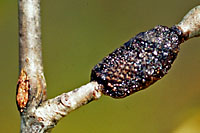 The big problem with this strategy is that the moths tend to lay
their eggs in the upper part of large trees. So, it may not be very
practical, unless you're willing to hire a tree climbing crew?
The big problem with this strategy is that the moths tend to lay
their eggs in the upper part of large trees. So, it may not be very
practical, unless you're willing to hire a tree climbing crew?
As an alternative to, or in combination with the removal of egg masses, there are several biological control materials based on the naturally occurring soil bacteria, Bacillus thuringiensis or “Bt,” that can be sprayed on the emerging leaves of infested trees during the first couple of weeks in May. These specific Bt formulations are very effective against newly hatched forest tent caterpillars, and at the same time are very gentle on the environment.
Again, if your trees are large, you'll have to hire a licensed pesticide applicator as they have the equipment necessary to get the materials fifty feet or more into the air!
Finally, as difficult as it may be to do nothing, that may be your best option?
As I mentioned above, infestations of forest tent caterpillars are very cyclic. Since the infestation has been pretty bad the past couple of years, I wouldn't be at all surprised if it's less severe this coming spring and almost non-existent a couple of years from now.
And, looking far into the future, it could be decades before this pest once again becomes a nuisance in Central New York!
Picture Credits
Several of the pictures on this page were obtained from Forestry Images, a joint digital image archive and database project between the Bugwood Network at the University of Georgia and the USDA Forest Service. While these images are in the public domain, I would like to thank the following photographers for participating in this important educational project:
- Eastern Tent Caterpillar
- Lacy L. Hyche, Auburn University
- Eastern Tent Caterpillar Web
- Tim Tigner, Virginia Department of Forestry
- Female Forest Tent Caterpillar Moth and Eggs
- Scott Tunnock, USDA Forest Service
- Forest Tent Caterpillar Egg Mass
- Steven Katovich, USDA Forest Service